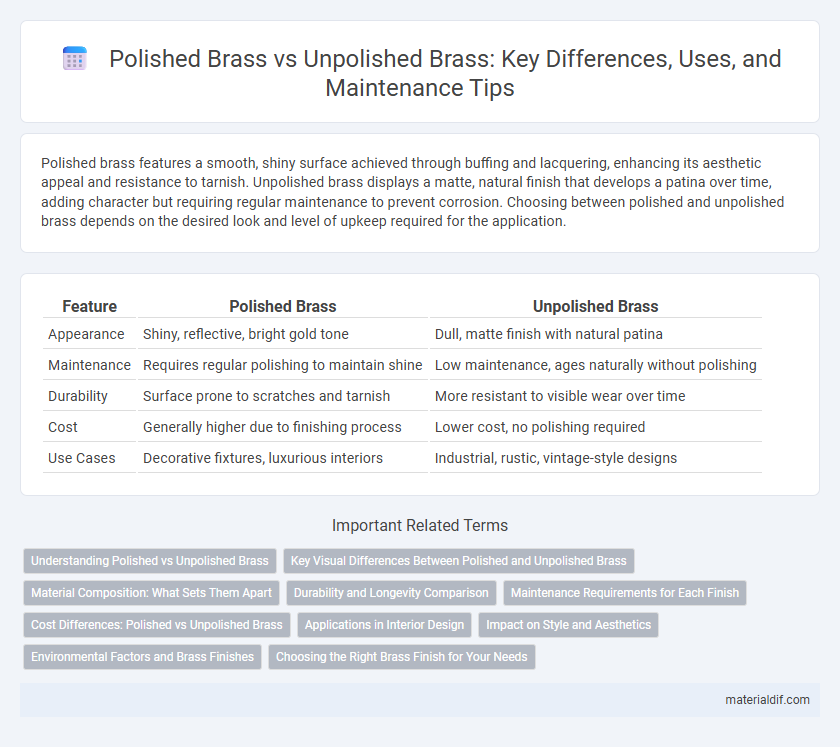Polished brass features a smooth, shiny surface achieved through buffing and lacquering, enhancing its aesthetic appeal and resistance to tarnish. Unpolished brass displays a matte, natural finish that develops a patina over time, adding character but requiring regular maintenance to prevent corrosion. Choosing between polished and unpolished brass depends on the desired look and level of upkeep required for the application.
Table of Comparison
| Feature | Polished Brass | Unpolished Brass |
|---|---|---|
| Appearance | Shiny, reflective, bright gold tone | Dull, matte finish with natural patina |
| Maintenance | Requires regular polishing to maintain shine | Low maintenance, ages naturally without polishing |
| Durability | Surface prone to scratches and tarnish | More resistant to visible wear over time |
| Cost | Generally higher due to finishing process | Lower cost, no polishing required |
| Use Cases | Decorative fixtures, luxurious interiors | Industrial, rustic, vintage-style designs |
Understanding Polished vs Unpolished Brass
Polished brass features a smooth, shiny surface achieved through buffing and coating, enhancing corrosion resistance and aesthetic appeal, while unpolished brass retains a natural, matte finish that may develop a patina over time. The choice between polished and unpolished brass impacts maintenance requirements and durability, with polished brass demanding regular upkeep to prevent tarnish. Applications such as decorative hardware and musical instruments often favor polished brass for its bright appearance, whereas industrial uses may prefer unpolished brass for its rugged, authentic look.
Key Visual Differences Between Polished and Unpolished Brass
Polished brass features a smooth, reflective surface with a bright, golden shine, highlighting its lustrous and clean appearance. Unpolished brass has a matte finish with a muted, slightly darker tone due to oxidation and natural patina formation. The key visual difference lies in the polished brass's glossy, mirror-like quality versus the unpolished brass's rustic, textured look.
Material Composition: What Sets Them Apart
Polished brass and unpolished brass differ primarily in surface finish rather than material composition, as both are typically composed of a copper-zinc alloy with varying zinc content between 5% and 40%. Polished brass undergoes extensive buffing and coating processes to create a shiny and reflective surface, enhancing corrosion resistance and aesthetic appeal. Unpolished brass retains a natural, matte finish that may develop a patina over time due to oxidation but offers a more rustic and authentic look.
Durability and Longevity Comparison
Polished brass features a smooth, glossy surface achieved through regular buffing and lacquer application, enhancing its resistance to tarnish and corrosion, which can significantly extend its lifespan in both indoor and outdoor environments. Unpolished brass, while initially more susceptible to oxidation and developing a patina over time, can maintain structural durability but often requires more maintenance to prevent surface degradation. The longevity of polished brass generally surpasses unpolished brass due to its protective finish, making it ideal for decorative applications where aesthetic preservation and long-term durability are priorities.
Maintenance Requirements for Each Finish
Polished brass requires regular cleaning and frequent polishing to maintain its shiny, reflective surface and prevent tarnishing. Unpolished brass has a natural, matte finish that develops a protective patina over time, reducing the need for constant upkeep. Choosing between polished and unpolished brass significantly affects maintenance routines and long-term appearance durability.
Cost Differences: Polished vs Unpolished Brass
Polished brass typically incurs higher costs due to the additional labor and materials required for buffing, polishing, and finishing processes that enhance its shine and resistance to tarnish. Unpolished brass, being closer to its natural state, demands less processing, resulting in lower production expenses and more affordable pricing. The choice between polished and unpolished brass hinges on budget considerations versus desired aesthetic and maintenance requirements.
Applications in Interior Design
Polished brass is prized in interior design for its reflective, golden finish, making it ideal for decorative fixtures like door handles, light sconces, and cabinet hardware that enhance luxury and elegance in spaces. Unpolished brass, with its matte and aged appearance, suits rustic or industrial themes, often used in accent pieces, furniture trims, and lighting to create a vintage or understated look. Both finishes offer durability and corrosion resistance, allowing designers to select based on aesthetic preference and the desired ambiance in residential or commercial interiors.
Impact on Style and Aesthetics
Polished brass features a shiny, reflective surface that enhances elegance and sophistication, making it ideal for traditional and upscale interiors. Unpolished brass exhibits a matte, rustic finish that adds warmth and vintage charm, often preferred in industrial or farmhouse styles. The choice between polished and unpolished brass significantly influences the overall aesthetic by either prioritizing sleek luxury or a more natural, aged look.
Environmental Factors and Brass Finishes
Polished brass features a smooth, reflective surface achieved through extensive buffing and lacquering, which enhances corrosion resistance against environmental factors like humidity and air pollution. Unpolished brass, often left with a natural matte or slightly oxidized finish, develops a patina over time that can protect the metal from further environmental degradation. Choosing between polished and unpolished brass finishes depends on the desired aesthetic and the level of environmental exposure, as polished brass requires more maintenance to prevent tarnishing.
Choosing the Right Brass Finish for Your Needs
Polished brass offers a shiny, reflective surface that enhances aesthetics in decorative applications, while unpolished brass provides a matte, natural look ideal for industrial or rustic settings. Choosing the right brass finish depends on factors such as desired appearance, maintenance requirements, and environmental exposure. Polished brass requires regular cleaning to prevent tarnishing, whereas unpolished brass develops a unique patina over time, adding character without frequent upkeep.
Polished Brass vs Unpolished Brass Infographic

 materialdif.com
materialdif.com